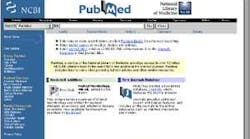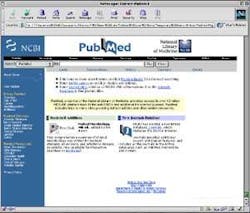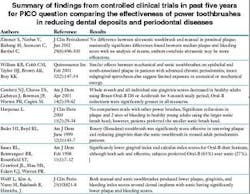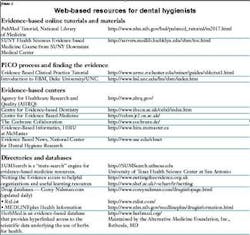by Denise M. Bowen, RDH, MS and Jane L. Forrest, RDH, EdD
Dental hygienists are bombarded on a regular basis with information about new technologies, treatment modalities, and oral health products. We receive professional journals and magazines containing articles, testimonials, and advertisements about everything from toothbrushes and floss to periodontal endoscopy and lasers. Sales representatives also visit dental hygienists in practice, often-delivering information, demonstrations, and literature about new or improved products. With so many choices to make, it can be difficult to know where to most wisely invest limited resources for the benefit of our patients.
National surveys indicate that practicing dental hygienists most frequently obtain information from their colleagues, experts in the field, or continuing education courses1,2. Because of the demands of our patient schedules, hygienists generally do not have time at work to use electronic databases to search current literature unless we work in alternative settings such as education, public health, or hospital programs. Other health professionals, including dentists, physicians, and nurses, report similar means of obtaining current information related to patient care3.
"Evidence-based health care" (EBHC) is the solution, according to the experts, the government, and the insurance industry. EBHC suggests that practitioners should explicitly use scientific evidence to make decisions that maximize the potential for successful patient care outcomes4. Decisions about which treatments or procedures should be used, given a particular diagnosis, and even which of those should be reimbursed, increasingly are being based on research data collected by these entities. Dental hygienists, like other health professionals, are hesitant to embrace this concept because we believe, although perhaps inaccurately, that it often ignores our own judgment and our patients' individual needs.
As a result, leaders in the dental hygiene profession at the National Center for Dental Hygiene Research (NCDHR) have developed a model for "evidence-based decision-making" (EBDM), based on the original intent of those who developed this concept4. This model has four components, including the hygienists' clinical experiences, the patient's preferences, individual circumstances pertaining to the case, and current scientific evidence. The NCDHR fosters the use of EBDM because dental hygiene clinicians can never be completely current regarding all conditions, medications, materials or available products. EBDM provides a mechanism for addressing these gaps in knowledge so hygienists can provide the best care possible. The American Dental Hygienists' Association (ADHA) also has policy supporting "evidence-based, patient-centered" dental hygiene care. "Our focus as dental hygienists has always been the client," states Maria Perno, author and past president of ADHA. "As more research is being conducted that supports enhanced oral health outcomes, it is logical to emphasize its importance in delivery of quality dental hygiene care."
Easily accessing the most credible and current scientific evidence remains a challenge for clinicians. A simple method known as PICO can help dental hygienists obtain answers to clinical questions4. PICO is an acronym for patient or problem, intervention, comparison, and outcomes. Questions that arise as we practice almost always begin with a patient. Periodontal pockets continue to go downhill. Patients inquire about some new oral hygiene device or bleaching agent. Or an unknown condition is detected during oral assessment. Unless you have unusually long appointments, it is impractical to excuse yourself and go look up the solution to this problem while providing patient care. An alternative would be to tell the patient that you will "look it up and get back to them with the most up-to-date information." Using the Internet and the PICO system, the answer to a patient-centered question can be obtained in about 20 minutes. If an Internet connection is available in the office, the question can be answered during a cancellation or whenever time might permit. More realistically, the question can be answered at home or anywhere that the Internet is available (public libraries, cafes, etc.).
Formulation of a specific question starts the process. If a patient with generalized plaque and calculus and clinical signs of periodontal disease asks which power toothbrush they should buy to help control periodontal disease, the dental hygienist can find information that will directly answer that inquiry. Using the PICO format, the hygienist selects the patient or problem (dental deposits and periodontal disease), the intervention (power toothbrushes), a comparison (oscillating (Oral-B) versus sonic toothbrushes), and a desired outcome (reduced dental deposits and periodontal disease).
The PICO question would be, "For patients with dental deposits and periodontal disease [P], do oscillating (Oral-B) [I] as compared to sonic [C] toothbrushes better reduce dental deposits and periodontal disease [O]?"
Hygienists can access PubMed, (the free version of MEDLINE), an electronic database containing dental and medical literature by going to http://pubmed.gov on the Internet (see figure 1). PubMed has an excellent tutorial that can walk you through the steps. By phrasing the question using PICO, you now have key words to use in conducting your search. Under subject, type the words, "power toothbrushes AND oscillating OR sonic AND dental deposits AND periodontal disease." Before searching, click on limits to limit your search to specific dates (for example, May 1997 to May 2003 for the past six years), the English language, humans, and randomized controlled trials as the preferred publication type. Then select abstracts to be displayed (see figures 2-4).
Six abstracts and bibliographic references appear that directly answer that question based on current published literature. These abstracts can be reviewed for their quality and for relevance to the specific patient scenario you are considering and then selected for printing. Search results for this PICO question are summarized in Table 1. One study addressed only ultrasonic toothbrushes. For the sonic brush, one study showed no benefit of sonic or mechanical toothbrushes in reducing microbial counts in periodontal pockets, suggesting no acoustical or mechanical effect "beyond the bristles." Another study showed significant reductions in plaque and bleeding scores with the larger sonic brush head, although patients preferred the smaller one. One study found the rotary toothbrush to be more effective than the sonic brush in reducing plaque and gingivitis in treated adult periodontitis cases. The last one showed the sonic brush more effective than manual in reducing plaque and bleeding around dental implants. In the other two studies, Oral-B was shown to be significantly more effective than sonic in reducing gingivitis and calculus scores in healthy adults, and also more effective than battery operated toothbrushes in reducing gingivitis scores in healthy adults. Patients in the latter study also preferred the Oral-B power toothbrush two to one over the sonic toothbrush.
A telephone call or note to the patient provides a well-informed, personalized response related to that individual's needs and conditions. I have found patients to be so appreciative that they mention this personal service to others. What a practice builder as well as a way to easily add scientific evidence to decision making!
Other Websites publish scientific literature reviews or evidence-based summaries (see table 2 for several online resources and databases). For example, the American Academy of Periodontology has a link to its resources, guidelines, position papers, and parameters of care on various topics including, but not limited to, tobacco use, diabetes, heart disease, and other risk factors affecting periodontal disease as well as various periodontal therapies such as lasers, chemotherapeutics, soft tissue curettage (http://www.perio.org/resources-products/posppr2.html).
The Cochrane Collaboration publishes evidence-based reviews in all areas of health care including oral health. A few examples of their papers include fluoride gels, oral candidiasis, and mucositis in cancer patients undergoing chemotherapy, and dentine hypersensitivity. Recently, a Cochrane review of manual vs. power toothbrushes was published. A meta-analysis, the highest and most credible form of evidence, was used to evaluate all related research published since1966. Studies were only included in the analysis if they met pre-established criteria assuring validity.
For example, randomization was required to reduce bias; subjects had to use the brushes for at least four weeks; and changes in both plaque and gingivitis had to be measured. Of 354 studies identified in the search, only 29 met the standards established for quality of research design. These studies included 2,547 participants. Results showed that power brushes that use a rotation oscillation action (Oral-B 3D and Ultra models and Philips Jordan HP735) remove more plaque and reduce gingivitis more effectively in the short-term (four to eight weeks) and long-term (longer than eight weeks). No other power brush designs were consistently better than manual toothbrushes. It is interesting to note that the previously described PICO search on this topic found similar results, albeit being a quick and easy means of answering a clinical question.
The NCDHR has two Web sites, Evidence-Based News (http://www.usc.edu/ebnet) and DHNet (http:// www.usc.edu/dhnet), with links to many other sites specifically selected for dental hygienists. Also, several government sites, such as the National Oral Health Information Clearinghouse (NOHIC), provide information that has been reviewed and compiled by experts for use by professionals and consumers (http://www.nohic. nidcr.nih.gov/). In fact, patient brochures can be ordered at no charge in English and in Spanish languages. These are only a few of the places to easily access information related to dental hygiene practice.
Credible, evidence-based resources are readily available to dental hygienists facing decisions about patient care. Frequent use of scientific evidence from electronic sources can enhance decisions by adding one more dimension to the dental hygienist's clinical experiences, the patient's needs or preferences, and the specific situation that needs to be addressed.
Denise M. Bowen, RDH, MS is a professor in dental hygiene at Idaho State University. She currently is available to teach EBDM continuing education courses for dental hygienists throughout the United States and Canada. Jane L. Forrest, RDH, EdD, is acting chair, division of health promotion, disease prevention and epidemiology at the University of Southern California School of Dentistry. She teaches research and EBDM to dental hygiene students, dental residents, and health professions faculty throughout the country. Forrest is an associate editor for the Journal of Evidence-based Dental Practice and author of the ADHA White Paper on Evidence-Based Decision Making in Dental Hygiene Education, Research and Practice.
References1 Finley-Zarce SR, Overman PR, Mayberry WE, Correy AM. Information-seeking behaviors of US practicing dental hygienists and full-time dental hygiene educators. J Dent Hyg 2000 Spring; 76(2): 116-24.2 Gravois SL, Bowen DM, Fisher W, Patrick SC. Dental hygienists' information seeking and computer application behaviors. J Dent Ed 1995; Nov 59(11):1027-33.3 McNight M & Peet M. Health care providers' information seeking: recent research. Med Ref Serv Q 2000 Summer; 19(2):27-50.4 Sackett D, Richardson W, Rosenberg W et al. Evidence-based medicine: How to practice and teach EBM. 1997; New York: Churchill Livingston.5 National Library of Medicine. PubMed Tutorial. National Library of Medicine, NIH. Accessed November 12, 2002. http://www.nlm.nih.gov/bsd/pubmed_tutorial/m2017.html6 National Library of Medicine, NCBI. PubMed. National Library of Medicine, NIH. 2001. http://pubmed.gov7 Heanue M, Deacon SA, Deery C, Robinson PG, WalmsleyAD, Worthington HV, Shaw WC. Manual versus powered toothbrushing for oral health (Cochrane Review) In: The Cochrane Library, Issue 1, 2003. Oxford: Update Software.











